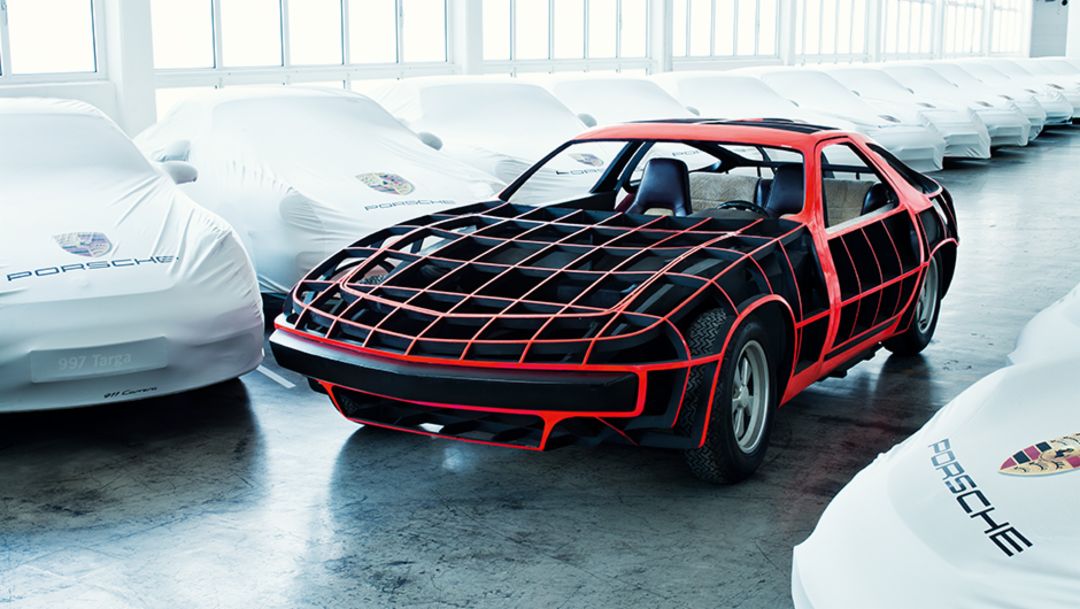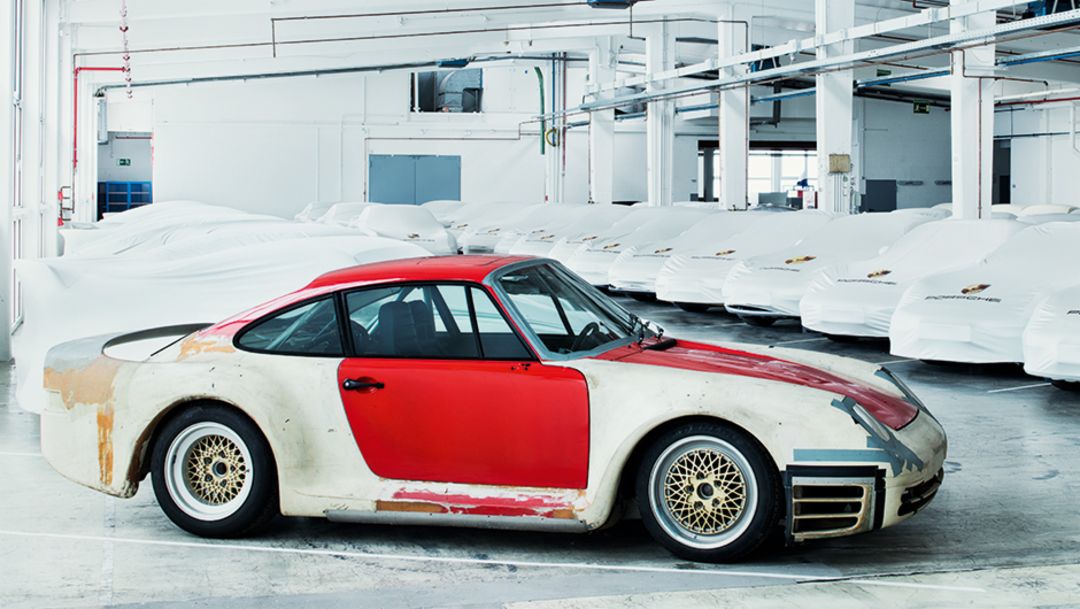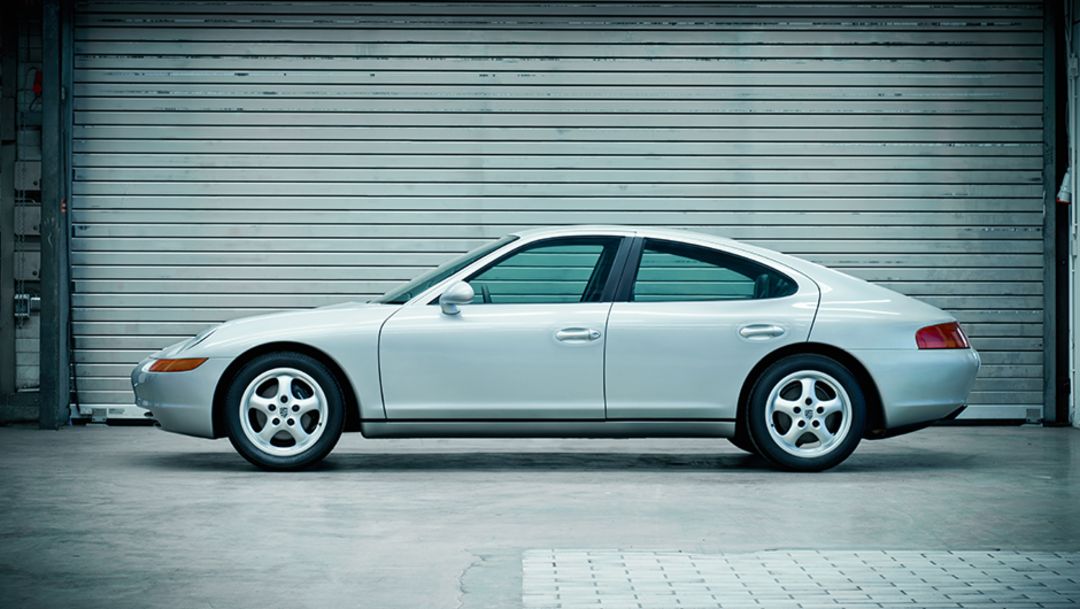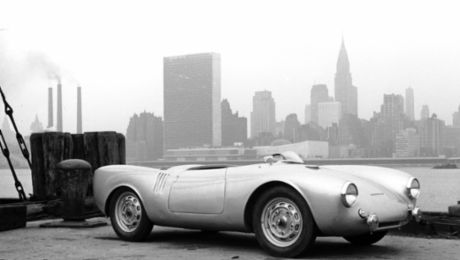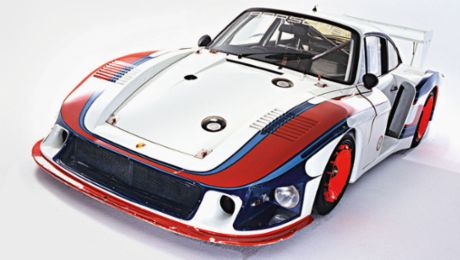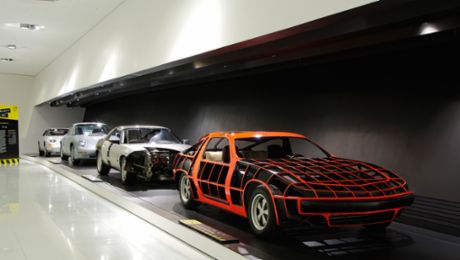Porsche 924
World record car: With the 924, Porsche broke new ground in 1976. As a timely response to the energy crisis, the attractively priced and economical four-cylinder sports car was intended to appeal to potential new customers. Porsche wanted to go in new directions in terms of marketing, too, and planned to draw attention with a high-speed world record drive. The goal of an average speed of over 250 km/h over a distance of 10,000 miles required a Porsche 924 optimized for long-distance records. The result: instead of the standard 92 kW (125 hp), the turbocharged world-record four-cylinder put out a splendid 184 kW (250 hp). The aerodynamics also received special attention. After extensive wind-tunnel testing, the drag coefficient was an outstanding Cd 0.268, which enabled a top speed of 280 km/h. Shortly before the planned record-breaking drive in July 1977, the world-record attempt was put on ice for strategic reasons. Instead of ripping around the high-speed oval of Nardò, the fastest 924 of all time rolled into the newly founded Porsche Museum.
Years: 1976/77
Engine: Four-cylinder turbo
Displacement: 1,984 cc
Power: 184 kW (250 hp)
Weight empty: 980 kg
Top track speed: 280 km/h
Porsche 984
Sports two-seater concept car: As a study for a future vehicle concept, between 1984 and 1987 the Porsche Development Center in Weissach worked on a compact, lightweight, and aerodynamic roadster. The project was inspired by a development job previously undertaken for the Spanish automaker Seat. As a small and relatively inexpensive sports car in the price range of 40,000 German marks, the Porsche 984 was designed to appeal to a young, sporty clientele. The development objective was primarily focused on dynamic driving characteristics, to be achieved through low driving resistance rather than massive engine power. Low fuel consumption was also defined as a development objective. A drive concept with an air-cooled two-liter, four-cylinder rear boxer engine and an output of 88–110 kW (120–150 hp) was aimed at emphasizing the technological distinctiveness of the model. A convertible version with an innovative folding hard-top was envisioned, as was an all-wheel-drive model for motor racing. The sales crisis precipitated by the plummeting dollar in 1987, however, put an early end to the 984 project.
Years: 1984 to 1987
Engine: Four-cylinder boxer
Displacement: 1,984 cc
Power: 99 kW (135 hp)
Weight empty: 880 kg
Top track speed: 220 km/h
Concept Car Type 995
Research car: Commissioned by the Federal Ministry of Research and Technology, in 1978/79 Porsche developed a concept for the construction of a future sports car. The development objectives for the four-seater Type 995 concept car focused in particular on fuel economy, safety, and noise emissions. The engineers in Weissach used a Porsche 928 as the technological basis for the research prototype. Special features of the concept car included a five-speed double-clutch transmission in conjunction with two low-consumption gas engines. Plans envisioned a high-compression three-liter V8 engine with automatic cylinder deactivation as well as a 2.2-liter four-valve, four-cylinder alternative. The gear-shifting of the double-clutch transmission was electronically controlled without letting up on the gas, which contributed to the high efficiency of the drive system. In combination with a lightweight, aerodynamic aluminum body, the calculated consumption came in under 9 liters per 100 km. In addition to a comprehensive package of passive safety measures, an optimized anti-lock brake system enhanced active driving safety.
Years: 1978 to 1979
Engine: V8
Displacement: 3,000 cc
Power: 96 kW (130 hp)
Weight empty: 1,290 kg
Top track speed: 200 km/h
Porsche 959
C29 aerodynamics study: At the Frankfurt International Motor Show in 1983, Porsche presented a high-performance vehicle that would provide an impressive demonstration of the brand’s innovative drive: the “Group B” study. The production-ready version of the concept known as the Porsche 959 underlined the technical expertise of the company in 1985. Powered by a 331 kW (450 hp) boxer engine with water-cooled cylinder heads and bi-turbo sequential charging, the car topped the 300 km/h (186 mph) barrier with playful ease. The electronically controlled chassis, the program-controlled all-wheel drive, and the aerodynamically optimized body broke new ground for later Porsche sports-car generations. As the predecessor of the Porsche 950, the Type 959 C29 represented the beginnings of this ambitious project. It was used for extensive wind-tunnel testing in 1982, which resulted in a low Cd-value of 0.31 paired with an optimal lift coefficient. The special characteristics of the C29 include the rear wing integrated in the bodyshell, the smooth transition from the windshield to the A-pillar, and the aerodynamic plastic underbody cover.
Year: 1982
Engine: Six-cylinder boxer bi-turbo
Displacement: 2,849 cc
Power: 331 kW (450 hp)
Weight empty: 1,450 kg
Top track speed: 315 km/h
Porsche 989
Concept car: With Porsche in the midst of an economic downturn in the late 1980s, it was decided in 1988 to begin development on a new model line with a project named 989. As a four-door “family sports car” or “Porsche for more than two,” the front-engine V8 sports sedan with rear-wheel drive was to hit the market by 1995 and target a new market segment. But even during the initial project phase, development costs for the technically sophisticated four-door rose to improbable heights, making it impossible to keep the purchase price below 100,000 German marks. When the price calculation ultimately topped 150,000 German marks and the envisioned annual production quantity of 15,000 units could not be achieved economically, the supervisory board stopped the project in January of 1991. The efforts were not entirely in vain, however; many of the ideas and detail solutions found their way into future Porsche models such as the 996 type series of the 911.
Year: 1991
Engine: V8
Displacement: 4,200 cc
Power: 257 kW (350 hp)
Weight empty: 1,572 kg
Top track speed: 279 km/h
"Project: Secret!" in the Porsche-Museum
“Project: Secret!” in the Porsche Museum From September 17, 2014, to January 11, 2015, the Porsche Museum will present the special exhibition “Project: Secret!” with never-built studies, unknown concept cars, and camouflaged prototypes from Porsche over the decades. A total of sixteen cars will be on display, as will miniatures from the Porsche archive and rediscovered design drawings.
Info
Text first published in the Porsche customer magazine Christophorus, No. 368.



